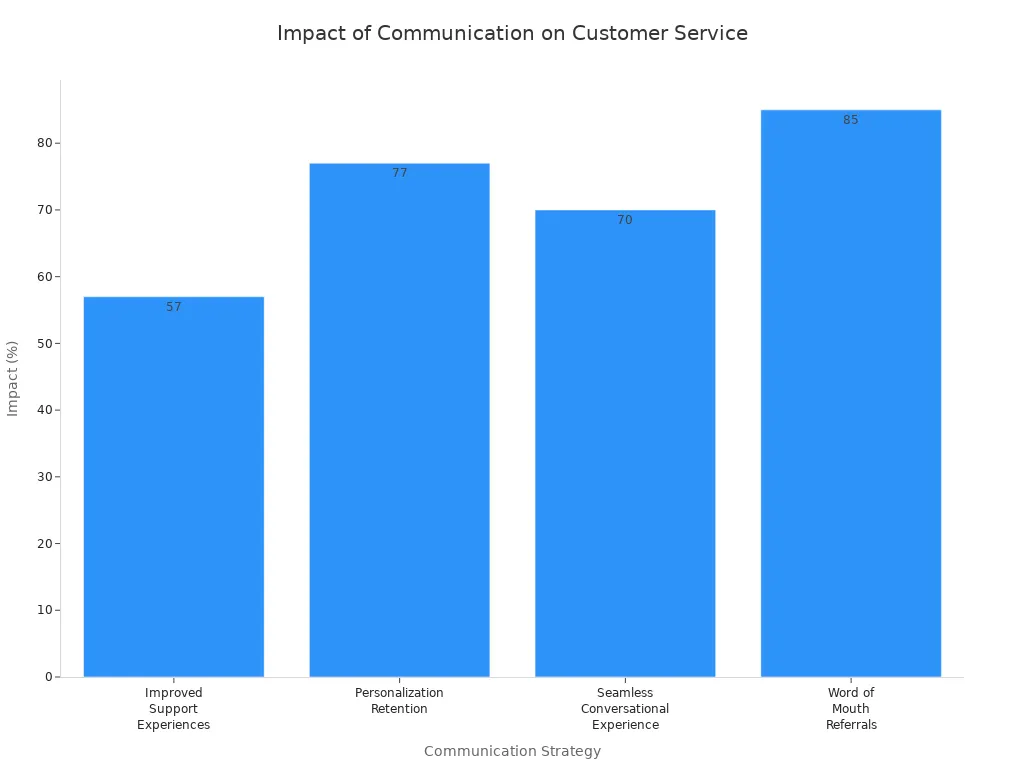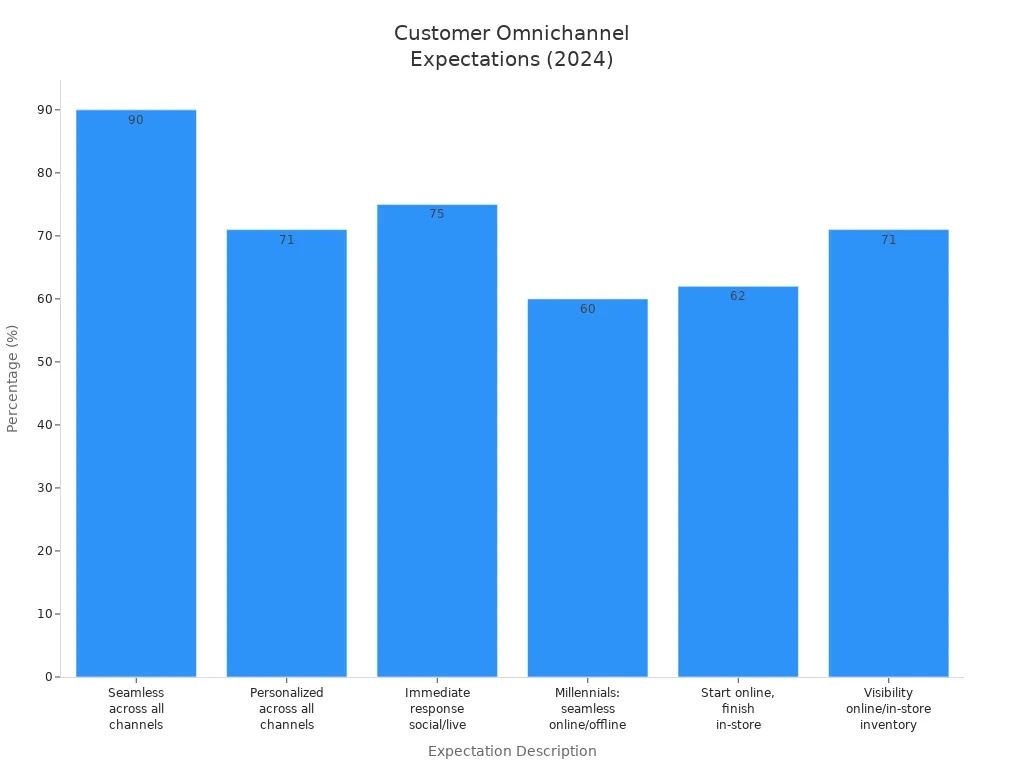Key Elements Every Customer Service Model Should Have

A strong customer service model shapes brand loyalty and business success. Essential customer service models include communication, empathy, rapid response, knowledge, and feedback. These elements matter because 45% of customers switch brands after poor service, while 61% value friendly employees.
| Statistic Description | Percentage | Year |
|---|---|---|
| Customers who switched brands due to poor customer service | 45% | 2024 |
| Consumers citing friendly employees as a top factor in loyalty | 61% | 2024 |
Industry studies show that effective customer service models drive retention, boost satisfaction, and increase profits. Sobot AI and Sobot call center help businesses deliver consistent customer satisfaction and growth.
Essential Elements
Communication
Clear communication forms the backbone of every customer service model. Companies that prioritize accessible and effective communication channels see higher customer satisfaction and loyalty. According to industry research, 57% of consumers report improved support experiences when businesses enhance their communication strategies (Zendesk CX Trends Report 2023). Communication involves more than just speaking or writing; it requires listening, understanding, and responding in a way that addresses customer expectations.
Tip: Unified communication platforms, like Sobot's all-in-one contact center, help agents manage calls, chats, and messages from a single workspace, ensuring no customer inquiry goes unnoticed.
| Evidence Type | Details | Impact on Customer Service Outcomes |
|---|---|---|
| Statistical Data | 57% of consumers noticed improved support experiences due to better communication strategies. | Improved communication directly enhances customer support quality. |
| Business Leader Insight | 77% of business leaders say personalization increases customer retention. | Personalized communication fosters loyalty and satisfaction. |
| Consumer Behavior | 70% of consumers purchase more when receiving seamless conversational experiences across channels. | Effective omnichannel communication drives sales growth. |
| Case Study: Syfe | Unified communication platform with 24/7 agent availability led to rapid customer base growth in Asia-Pacific. | Integrated communication strategies improve customer satisfaction and business expansion. |
| Case Study: Utila Dive Center | Omnichannel communication and personalized interactions resulted in 80-90% of candidates referred by word of mouth. | Personalized, consistent communication generates positive word-of-mouth and retention. |
| Case Study: Banc Sabadell | AI-based chat assistant and self-service options reduced call volume and improved service efficiency. | Proactive and technology-supported communication enhances customer experience and operational efficiency. |
| Communication Channels | Omnichannel approaches (email, phone, chat, social media) meet customer preferences and improve experience. | Consistent communication across multiple channels meets customer expectations. |

A successful customer service model empowers agents to solve problems quickly and avoid unnecessary transfers. Companies should offer multiple support options, such as phone, email, live chat, and social media, to meet diverse customer expectations. Sobot's omnichannel solution enables businesses to unify these channels, providing a seamless experience for both customers and agents.
Empathy
Empathy stands as a cornerstone of effective customer service models. When agents demonstrate empathy, they build trust, reduce stress, and foster cooperation. This approach leads to higher First Call Resolution (FCR) and customer satisfaction scores. Customers who feel heard and understood are more likely to remain loyal and recommend the brand to others.
Note: Emotional intelligence allows agents to recognize and respond to customer emotions, which strengthens customer relationships and reduces churn.
- Emotional intelligence helps agents understand customer emotions, enabling empathetic responses.
- Empathy improves problem-solving by recognizing emotional cues and addressing needs effectively.
- Demonstrating empathy increases customer satisfaction and loyalty.
- Empathy builds trust and rapport, with 93% of customers making repeat purchases from companies providing great service.
Empathy also plays a vital role in conflict resolution. Agents who listen actively and acknowledge customer feelings can resolve issues more efficiently. Sobot's AI-powered chatbots and live chat tools support agents by providing relevant information, allowing them to focus on building genuine connections with customers.
Response Time
Quick response times are essential in any customer service model. Customers expect timely replies across all channels, whether through email, live chat, phone, or social media. Delays can lead to frustration and lost business, while prompt responses reassure customers and build trust.
| Channel | Typical Customer Expectation | Industry Benchmark / Best Practice | Impact on Customer Satisfaction |
|---|---|---|---|
| 89% expect response within 1 hour; 31.2% within 15 minutes | Best-in-class: 1-2 hours | Quick replies reassure customers and reduce frustration | |
| Live Chat | Response within seconds | Top businesses respond under 30 seconds | Delays cause abandonment; fast replies increase satisfaction |
| Phone | Acceptable wait ~2 minutes | Healthcare/Finance aim under 2 minutes | Efficient support reduces frustration, especially for urgent issues |
| Social Media | Twitter: 78% expect response within 1 hour; Facebook within 4 hours | Fast responses improve loyalty and engagement | Slow replies harm brand reputation |
Proactive service models balance speed with quality. Rushing interactions can harm emotional connection and reduce satisfaction, so agents must respond quickly while maintaining empathy and accuracy.
Sobot's cloud call center offers intelligent routing and real-time monitoring, helping businesses achieve industry-leading response times. The platform's AI-powered voicebot and unified workspace ensure that agents can handle inquiries efficiently, meeting customer expectations for quick response times.
Knowledge
Knowledge empowers agents to deliver accurate solutions and build customer confidence. Well-trained staff can answer questions, resolve issues, and provide personalized support, which directly impacts customer satisfaction and loyalty. Product knowledge also enables agents to identify upselling opportunities and anticipate customer needs.
- Staff product knowledge builds employee confidence, enabling them to communicate with authority and handle complex inquiries effectively.
- It fosters customer trust by providing accurate, reliable information, which enhances brand reputation and encourages positive word-of-mouth.
- Well-informed employees deliver personalized support, reducing customer frustration and churn, thereby increasing retention.
- Product knowledge allows staff to identify upselling opportunities, contributing to business growth and deeper customer engagement.
- It improves efficiency by enabling quicker problem resolution and streamlining support processes, leading to better overall customer experience.
81% of consumers say brand loyalty depends on the quality of customer service, which hinges on agent knowledge.
Sobot's knowledge base and AI-driven solutions help agents access up-to-date information quickly. This support reduces average handle time and increases first-contact resolution rates, both of which are critical for a proactive service model.
Feedback
Customer feedback serves as a powerful tool for continuous improvement in customer service models. Feedback helps organizations identify pain points, accelerate improvements, and enhance support quality. Companies that act on feedback and communicate changes see increased loyalty and satisfaction.
| Case Study | Company | Role of Customer Feedback | Outcome |
|---|---|---|---|
| Improving Product Development | Intergiro (Swedish fintech) | Embedded surveys in product to gather feedback, enabling faster feature validation and informed decisions | 54% increase in engagement; development cycle accelerated by validating features twice as fast |
| Enhancing Customer Support | ParkBee (urban parking solutions) | Used CSAT surveys after each parking session to analyze customer journey and identify issues | 20% reduction in customer service contact rate; proactive issue resolution |
| Boosting Customer Retention | Taxfix (mobile tax filing app) | Personalized user journeys based on targeted surveys to understand user needs | Achieved a high Net Promoter Score (NPS) of 68, indicating strong customer loyalty |
- Closing the feedback loop by responding and communicating changes increases loyalty and satisfaction.
- Organizations with high Net Promoter Scores (NPS) experience 1.5 times higher revenue growth.
- Personalized engagement and follow-up communications validate customer opinions and encourage ongoing feedback.
- Proactive handling of negative feedback can significantly improve retention despite initial dissatisfaction.
Sobot's ticketing system and analytics tools enable businesses to collect, analyze, and act on customer feedback efficiently. By embedding feedback into long-term strategies, companies create a customer-centric culture and drive continuous improvement in their customer service model.
Communication in Customer Service

Clarity
Clear communication stands as the foundation of every successful customer service model. Companies that use clear communication prevent misunderstandings and deliver accurate information. Customers appreciate straightforward language because it builds trust and enhances their experience. When representatives use clear communication, they create a strong connection with customers and foster credibility. Honesty and transparency also play a vital role, helping customers feel confident in every response.
- Clear communication prevents confusion and ensures customers receive the right response.
- It builds trust and improves satisfaction, leading to stronger relationships.
- Empathy, paired with clear communication, allows representatives to acknowledge customer feelings and improve every interaction.
- Active listening supports clear communication by helping agents understand customer needs.
Active Listening
Active listening is essential for effective communication in customer service. Agents who practice active listening make customers feel valued and heard. This approach leads to quicker issue resolution and higher first-contact resolution rates. Customers who experience active listening are more likely to trust the brand and remain loyal.
- Active listening improves first call resolution, reducing call volume and operational costs.
- It builds trust and loyalty, increasing customer lifetime value.
- Agents identify needs faster, reducing call times and agent burnout.
- Customers who feel understood often leave positive feedback, boosting Net Promoter Scores and Customer Satisfaction ratings.
- Active listening helps agents handle upset customers, fostering authentic conversations and improving retention.
Sobot Voice/Call Center

Sobot Voice/Call Center transforms communication by providing a unified workspace for agents. The platform uses intelligent IVR and AI-powered voicebots to deliver clear communication and fast response. Companies using Sobot have seen measurable improvements in operational efficiency and customer satisfaction.
| Metric | Improvement |
|---|---|
| Reception Efficiency | Increased by 48% |
| Average Handle Time | Reduced by 41% |
| First-Contact Resolution Rate | Improved by 54% |
| System Uptime | 99.99% uptime |
| CRM Integration | Exceeded expectations |
Sobot ensures every response is accurate and timely. The system supports global telephony contacts and integrates easily with CRM systems. Agents can manage calls and customer data in one place, which streamlines communication and improves every response. Sobot Voice/Call Center helps businesses deliver clear communication and maintain high service standards (Sobot Voice/Call Center).
Personalization and Empathy
Customer Understanding
Understanding customer needs forms the foundation of a customer-centric service model. Companies use several methods to gain insights into what customers expect and value. Surveys and questionnaires collect structured feedback, while interviews and focus groups reveal deeper motivations and pain points. Customer journey mapping helps visualize the entire experience, highlighting areas where expectations are not met. Observational research, such as watching how customers interact with products or services, uncovers hidden needs. These approaches allow businesses to adapt quickly and deliver experiences that match customer expectations.
| Method | Description | Benefits/Insights |
|---|---|---|
| Surveys and Questionnaires | Collect data from large groups with targeted questions | Real-time feedback, cost-effective |
| Customer Interviews | Direct conversations to identify recurring issues | Qualitative insights, improves Net Promoter Scores |
| Focus Groups | Group discussions to explore attitudes and perceptions | Deeper motivations, unmet needs |
| Customer Journey Mapping | Visualizes the full customer experience | Pinpoints pain points and opportunities |
Sobot’s omnichannel solution helps companies gather and analyze feedback from every touchpoint, making it easier to understand and meet customer needs.
Tailored Interactions
Personalized service transforms customer interactions into memorable experiences. When companies use data to tailor content, offers, and recommendations, customers feel valued. A study by Epsilon found that 80% of consumers are more likely to purchase when brands personalize their experience (Epsilon research). Tailored interactions also boost satisfaction and loyalty, as customers receive relevant information at each stage of their journey.
- Tailored content and offers increase engagement and reduce friction.
- Personalization builds emotional connections, leading to higher Net Promoter Scores.
- Customers who experience tailored service are more likely to return and recommend the brand.
Sobot’s AI-powered chatbots and unified workspace enable agents to deliver personalized responses, ensuring every interaction meets customer expectations.
Building Trust
Trust grows when companies resolve issues quickly and show empathy during every interaction. Customers expect transparency and accountability, especially when problems arise. Research shows that 59% of customers leave after several bad experiences, while 17% leave after just one. Building strong customer relationships by listening and responding to feedback reduces churn and increases loyalty. Companies that empower customers with self-service options and provide consistent, reliable support see higher customer lifetime value.
- Net Promoter Score surveys help measure satisfaction and identify areas for improvement.
- Personalizing communications and offering satisfaction guarantees encourage long-term loyalty.
- Creating customer communities strengthens connections and trust.
Sobot’s solutions unify customer information, making it easier for agents to deliver seamless service and build lasting trust throughout all customer interactions.
Omnichannel Support
Unified Experience
Customers today expect seamless service across every channel. They want to start a conversation on one platform and continue it on another without repeating themselves. A unified experience means customers receive consistent, personalized service whether they use email, chat, phone, or social media. This approach builds trust and keeps customers engaged. Research shows that customers who interact with four or more channels spend 9% more than those using just one. Cross-channel shoppers spend 30% more per purchase. Companies that deliver a unified experience see higher satisfaction scores and stronger loyalty.
| Customer Expectation Description | Percentage |
|---|---|
| Consumers wanting seamless interactions across all channels | 90% |
| Customers expecting personalized experiences across all channels | 71% |
| Consumers expecting immediate response on social media or live chat | 75% |
| Millennials expecting seamless transitions between online and offline | 60% |
| Customers starting shopping online but finishing in-store | 62% |
| Consumers expecting visibility across online and in-store inventory | 71% |

Sobot Omnichannel Solution
Sobot Omnichannel Solution helps businesses deliver a unified customer support experience. The platform integrates channels like e-commerce, social media, websites, apps, email, and SMS. Agents can manage all conversations in one workspace, making it easy to track customer history and respond quickly. Sobot uses AI to route inquiries, analyze sentiment, and automate routine tasks. This reduces agent workload by 60% and improves response speed. Companies using Sobot have seen conversion rates rise by 15% and Net Promoter Scores increase by 35%. OPPO, a global brand, achieved 93% customer satisfaction and a 234% ROI after adopting Sobot. The platform supports multiple languages and provides over 300 detailed reports for process monitoring and quality inspection.
- Seamless integration of all customer channels
- 24/7 support with intelligent routing
- AI-powered personalization and workflow automation
- Secure, flexible, and easy to use for any business size
Self-Service Options
Self-service options empower customers to solve problems on their own. Features like knowledge bases, FAQs, and chatbots allow customers to find answers anytime. This reduces wait times and lowers the number of support tickets. Sobot’s self-service tools use AI to provide instant responses and personalized recommendations. Customers appreciate the convenience and control, which leads to higher satisfaction and loyalty. Self-service also frees agents to focus on complex issues, improving overall customer support efficiency. Companies benefit from lower costs and better data insights, which help them improve products and services.
- 24/7 access to support resources
- Faster issue resolution and reduced ticket volume
- Personalized experiences through AI-driven recommendations
- Consistent service and valuable analytics for continuous improvement
Technology in Customer Service Models

AI and Automation
AI and automation have transformed customer service models. Companies now rely on intelligent chatbots, virtual assistants, and automated workflows to deliver faster and more personalized support. By 2025, 80% of organizations plan to use AI-powered chatbots for customer service. In 2024, 26% of professionals have already integrated or are experimenting with AI in their workflows. Businesses use AI to improve agent efficiency, automate customer authentication, and summarize calls. Most decision-makers report benefits such as reduced costs and time savings.
- 35% of organizations use AI to boost agent productivity.
- 15% of contact centers employ generative AI for tasks like call summarization.
- 83% of companies plan to increase AI investments soon.
Sobot integrates AI-powered voicebots and chatbots into its contact center solutions. These tools combine knowledge and expertise to handle routine inquiries, freeing agents to focus on complex issues. Sobot’s automation features support agent training and ensure consistent service quality. Companies gain a competitive edge by leveraging both knowledge and expertise in every customer interaction.
Data Analytics
Data analytics plays a vital role in modern customer service. Businesses use analytics to understand customer behaviors, measure KPIs, and optimize workflows. Analytics enables companies to identify trends, forecast outcomes, and personalize support.
- Descriptive analytics reveals patterns in sales and customer sentiment.
- Predictive analytics uses historical data to anticipate future needs.
- Optimization and simulation techniques streamline operations.
- Augmented analytics automates data analysis, making insights accessible to all staff.
Sobot’s unified workspace provides real-time analytics, helping agents apply their knowledge and expertise to improve customer experience. Companies monitor metrics like NPS, CSat, and churn rate to refine their service strategies. Data-driven organizations use knowledge and expertise to enhance decision-making and increase customer loyalty.
Tip: Regular training helps staff interpret analytics and apply insights to daily operations.
System Reliability
System reliability remains essential for customer service platforms. Technical failures, human errors, resource constraints, and cyber threats can disrupt service and damage reputation. Integration issues also challenge system stability.
- Reliability problems cause customer frustration and loss of confidence.
- Downtime leads to financial losses and reduced retention.
- Proactive monitoring and redundancy help prevent disruptions.
Sobot’s cloud call center delivers 99.99% uptime, ensuring dependable service. The platform uses resilient architecture and continuous improvement practices to maintain reliability. Sobot’s commitment to training and operational excellence supports agents in delivering consistent customer experience. Reliable systems allow staff to use their knowledge and expertise without interruption, building trust with every interaction.
Building a Customer Service Model
Identifying Needs
A successful customer service model begins with a clear understanding of customer needs. Companies conduct a needs assessment to find gaps between current performance and desired outcomes. This process highlights areas for improvement and helps prioritize actions. Teams gather data from clients, high-performing employees, and managers to understand what works and what needs change. By analyzing these insights, organizations can streamline workflows and allocate resources where they matter most. Needs assessment also aligns business goals with customer expectations, ensuring the customer service model addresses real challenges. Sobot’s unified workspace supports this process by centralizing data, making it easier to identify trends and pain points.
Training Teams
Training plays a vital role in building an effective customer service model. Companies invest in both technical and soft skills development to prepare teams for diverse customer interactions. Modern training methods include AI-driven simulations, video tutorials, and role-playing exercises. These approaches help agents master communication, adapt to different personalities, and handle difficult scenarios. Blended learning strategies, such as combining in-person sessions with eLearning, keep training engaging and relevant. Sobot’s platform offers just-in-time resources and analytics, allowing managers to track progress and adjust training as needed. Regular training ensures staff stay updated on new products and service standards, which leads to better customer experiences.
Integrating Feedback
Integrating customer feedback drives continuous improvement in any customer service model. Companies collect feedback through surveys, social media, and direct conversations. They analyze both qualitative comments and quantitative trends to spot strengths and weaknesses. By acting on feedback, organizations can refine processes and enhance service quality. Key metrics like Customer Satisfaction Score (CSAT) and Net Promoter Score (NPS) help measure the impact of changes. Sobot’s ticketing and analytics tools make gathering customer feedback simple and actionable. Teams close the feedback loop by communicating updates to customers, showing that their input leads to real improvements. This approach builds trust and keeps the customer service model aligned with evolving customer needs.
Evaluating Customer Service Models
Performance Metrics
Companies rely on performance metrics to assess the effectiveness of customer service models. These metrics help leaders understand how well their teams meet customer needs and drive customer retention. Key indicators include response time, ticket resolution rate, and customer satisfaction scores. Net Promoter Score (NPS) measures loyalty and predicts customer retention rates. Agent utilization rate and average handle time show how efficiently staff work. Customer effort score reveals how easy it is for customers to get help. Businesses also track ticket volume, cost per resolution, and employee satisfaction scores. Qualitative metrics, such as customer surveys and call analysis, provide insights into communication skills and empathy. Monitoring these metrics allows organizations to identify strengths and areas for improvement in customer service models.
- Response Time (First Response Time, Average Response Time)
- Ticket Resolution Rate
- Customer Satisfaction Score (CSAT)
- Net Promoter Score (NPS)
- Agent Utilization Rate
- Average Resolution Time
- Average Handle Time
- Customer Effort Score
- Customer Ticket Volume
- Employee Satisfaction Score
- Cost Per Resolution
Continuous Improvement
Continuous improvement ensures customer service models remain effective and responsive to changing needs. Companies establish open communication channels so frontline staff can share feedback and ideas. Regular feedback sessions help teams discuss customer insights and brainstorm strategies. Leaders translate feedback into actionable changes, keeping employees engaged. Pilot programs allow teams to test new approaches before scaling them. Tracking progress with clear metrics, such as customer satisfaction scores and resolution times, helps organizations measure success. Adapting strategies based on ongoing feedback and data analysis maintains flexibility. Empowering frontline teams to act on service improvements increases responsiveness and customer retention rates. Technology, like Sobot’s analytics tools, supports continuous improvement by providing real-time data and actionable insights.
Tip: Companies that invest in training and technology see higher customer retention and satisfaction.
Customer Stories (e.g., OPPO)
Real-world examples show how successful customer service models drive results. OPPO, a global smart device brand, partnered with Sobot to improve its customer service. OPPO faced high inquiry volumes and needed efficient solutions. By implementing Sobot’s chatbot and ticketing system, OPPO achieved an 83% chatbot resolution rate and increased its repurchase rate by 57%. These results demonstrate the impact of advanced customer service models on customer retention and satisfaction scores.
| Metric | Result Achieved by OPPO |
|---|---|
| Chatbot Resolution Rate | 83% |
| Repurchase Rate Increase | 57% |
Sobot’s unified workspace and AI-driven automation helped OPPO streamline operations and deliver faster, more accurate support. Companies that adopt similar strategies can expect improvements in customer retention rates and overall service quality.
A strong customer service model drives customer satisfaction and business growth. Companies that focus on communication, empathy, and feedback create effective customer service. Regularly reviewing customer service models helps teams adapt to changing needs. Sobot’s solutions, trusted by brands like OPPO, support unified customer service models and improve satisfaction. Leaders should assess their customer service model, train teams, and use technology for continuous improvement. Adopting best practices ensures customer service models deliver lasting results.
FAQ
What is a customer service model?
A customer service model describes how a company supports customers. It includes communication channels, response times, and feedback systems. Sobot’s omnichannel solution helps companies build strong customer service models that improve customer satisfaction and loyalty.
How does Sobot improve customer satisfaction?
Sobot uses AI-powered chatbots, a unified workspace, and a cloud call center. These tools help agents respond quickly and accurately. OPPO increased its repurchase rate by 57% after using Sobot’s customer service model (OPPO case study).
Why is an omnichannel solution important for customer service?
An omnichannel solution lets customers reach support through phone, chat, email, or social media. Sobot’s omnichannel solution unifies these channels. Companies see higher customer satisfaction and retention when they use a seamless customer service model.
What metrics measure customer service model success?
Companies track response time, ticket resolution rate, and Net Promoter Score (NPS). Sobot’s analytics tools help managers monitor these metrics. High scores show strong customer satisfaction and an effective customer service model.
Can Sobot integrate with existing business systems?
Sobot integrates with CRM platforms and business systems. The omnichannel solution supports Salesforce and Shopify. This integration streamlines workflows and improves customer service. Sobot’s cloud call center also offers 99.99% uptime for reliable support.
See Also
Essential Principles For Managing Call Center Quality Systems
Top Ten Strategies To Improve Live Chat Support Experience
Proven Best Practices For Quality Management In Call Centers
Step-By-Step Guide To Deploy Omnichannel Contact Center Systems
